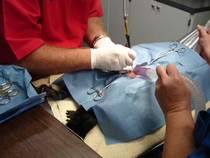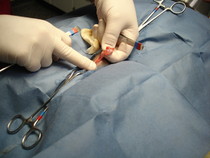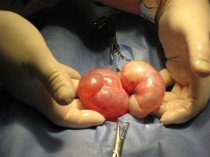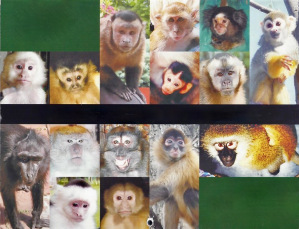Spay
To Spay or Not to Spay
Altering a monkey is a controversial topic. Some feel monkeys should not be altered in any way and left in their natural state, while others feel spaying and neutering is in the best interest of
the monkey when they do not intend to breed the monkey.
This article is not intended to encourage altering your monkey but to provide information for those who may be considering the procedure to help you make a more informed decision. As with any medical topics presented in our publications you should always consult with your veterinarian before making a final decision about medical issues for your monkey.
Will spaying or neutering a monkey help with aggression? Some argue "no" while others feel that it does. Generally, those with the viewpoint that it does not affect aggression are those who have not spent time around multiple monkeys who have been spayed or neutered to witness the difference in behavior. Many caretakers who have spayed or neutered their monkey feel that it has helped with aggressive behavior. However, a monkey will still be a monkey regardless as to whether it has been altered.
Some veterinarians will agree that spaying and neutering a monkey will help prevent some potential health problems later in life. Others refuse to alter a monkey in any way.
Neutering a monkey is a fairly simple surgical procedure performed by an experienced vet. Recovery is fairly quick, generally with no complications.
Spaying on the other hand is a more invasive surgical procedure and requires a much longer recovery period whereby the caretaker must be vigilant to assure the monkey does not pick at the
incision and remove the stitches. It is also important to make sure your monkey takes the full antibiotic prescription to prevent infection. Generally, you can expect a 2-week recovery period with
the first 4-5 days the most critical. Many caretakers arrange their schedules so they can basically wear their monkey the majority of that time to assure the stitches remain in place. Some monkeys
are bigger pickers than others.
Generally, a very small incision is made in the abdomen, either with surgical instruments or with a laser, and the ovaries and uterus are located and removed. Generally three layers of stitches
are used in the procedure and often metal staples are permanently used beneath the surface. Absorbable stitches can be used on the outer layer but most veterinarians opt for stronger stitches which
need to be removed about 2 weeks after the surgery.
In nature monkeys would not cycle month after month and would be bred and pregnant with offspring or nursing that offspring for several months out of each year. Monkeys in captivity who are not bred often have an enlarged uterus and ovaries as well as many cysts on their ovaries due to frequent cycling.
When prolonged health issues affect female reproductive organs, just as in humans, monkeys can experience severe discomfort as well as be at risk for the same complications as human woman who
experience severe female reproductive issues.
In the past 2 years one veterinarian encountered two capuchins (Cebus) with grossly enlarged ovaries, one a 12-year-old black capped (cebus
apella) capuchin and the second a 20-year-old white-faced (Cebus capucinus) capuchin.
<
The first, a [6 lb.] black-capped (cebus apella) capuchin came in for a routine spay and when the enlarged ovaries were discovered a larger incision was required to carefully
remove first one enlarged ovary then the second without rupturing them.
For emergency primate help or emergency placement please call:
Debbie Riga
864-630-7464
Ann Newman
501-339-5341
or email:










